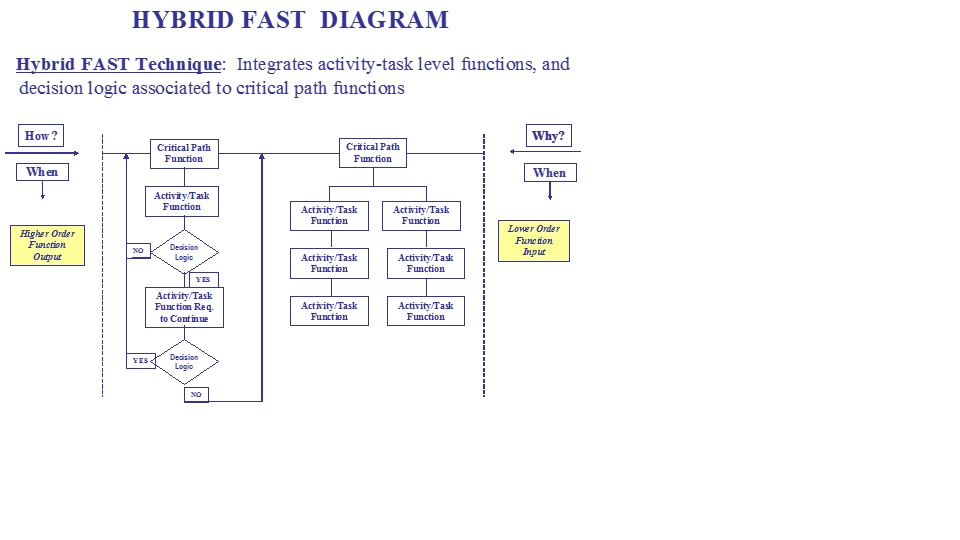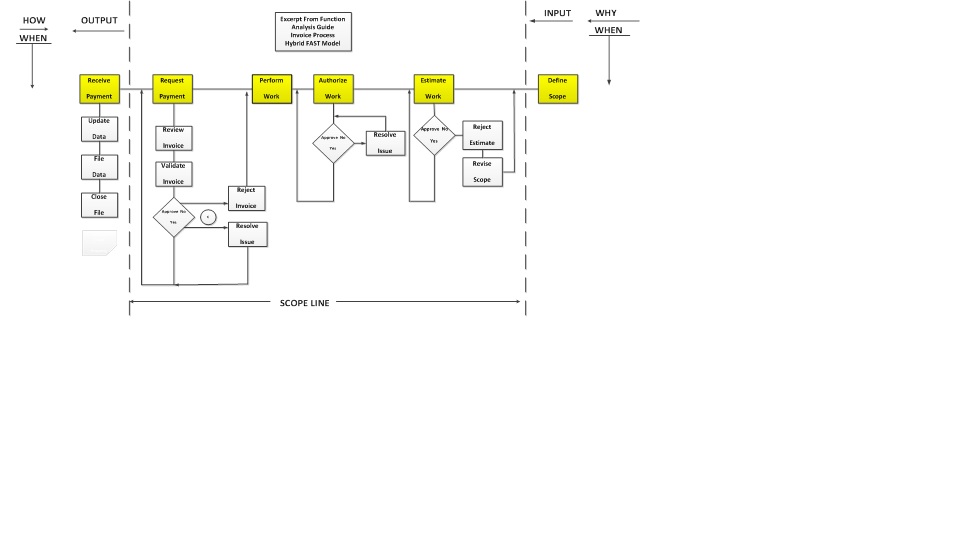By Bruce Lenzer, CVS-Life, FSAVE, CMQ/OE, CLA, CAQMSA – President, Lawrence D. Miles Value Foundation
Many years ago while using FAST for process type Value Engineering studies, it became evident teams needed a better way to express process flows along with function statements and the critical function logic path. In some cases, function statements were much too abstract to convey what the team needed for shared understanding. In fact, occasionally, the teams didn’t understand how the standard FAST diagram was really helpful, adjustments were made based on the team’s feedback. Then while building a prototype diagram with a team, and associating causative secondary function to the critical function logic path, the light went on. Why not build process task and activity function flow and decision logic in the vertical dimension of the FAST diagram? We experimented with a couple of teams, and in the end, teams concluded that adding these functions in the vertical dimension helped make better sense of the function statements along the critical function logic path. It also helped facilitate and communicate understanding and where there were opportunities for improvement.
There are many versions of Hybrid FAST including using other function model conventions in the same diagram. The basic form is building the typical FAST diagram in the precedent logic format in the horizontal X axis. When building the secondary functions in the vertical, the facilitator and/or team can use task and activity style function statements to build the function process flow in the vertical Y dimension. This is best illustrated by the diagram below: Decision logic is added in order to convey where there are conditional decision gates as part of the process. This is very similar to standard process flow diagramming with decision logic models, or diagrams which are typically constructed in the X axis dimension from left to right. In the case of a Hybrid Function model, the process task and activity steps with decision logic is constructed in the Vertical Y axis.
Decision logic is added in order to convey where there are conditional decision gates as part of the process. This is very similar to standard process flow diagramming with decision logic models, or diagrams which are typically constructed in the X axis dimension from left to right. In the case of a Hybrid Function model, the process task and activity steps with decision logic is constructed in the Vertical Y axis.
This technique has proven many times to assist in building “AS-IS” business process function models for function analysis and brainstorming. After proposals are developed and accepted, a “TO-BE” business process function model can be diagrammed which shows the new configuration and how the changes impact the overall process improvement. This modeling technique is also extremely helpful and valuable when determining costs to perform the function. There are other tools which can help interface organizational elements who perform the functions and processes. In addition, there are other conventions used to flag or highlight Value Opportunities and depict the specific proposal which contributes to the Value Improvement. More of this information will be shared in the coming Function Models Guide.
Many Value Methodology practitioners use this technique in several industries such as Nuclear, Aerospace, Project Delivery (For A/E projects), Facilities Management, Technology, Manufacturing, Laboratory R&D, Software Development, etc. It’s also applied to the indirect operations of a business such as procurement, supply chain/logistics, maintenance, materials management, and other aspects of operations, as well as the organization itself. One company even applied the technique to develop a new business joint venture and included all the business processes and related interfaces in one Hybrid business process function model.
An example using the invoice process from the SAVE International Function Guide, a Hybrid Function Model might look like the following:
 SAVE International, in conjunction with VM specialists from the Lawrence D. Miles Value Foundation, are assembling a guide book to help Value Methodology practitioners understand and apply different function modeling techniques and conventions. Hybrid FAST is just one of many which will be featured in this new work. Dr. Stephen Kirk, SAVE International VP Education, is leading this effort. SAVE International expects to release this new “Function Models” guide in 2018, and it will serve as a supplement to the Function Analysis Guide SAVE International released in 2016.
SAVE International, in conjunction with VM specialists from the Lawrence D. Miles Value Foundation, are assembling a guide book to help Value Methodology practitioners understand and apply different function modeling techniques and conventions. Hybrid FAST is just one of many which will be featured in this new work. Dr. Stephen Kirk, SAVE International VP Education, is leading this effort. SAVE International expects to release this new “Function Models” guide in 2018, and it will serve as a supplement to the Function Analysis Guide SAVE International released in 2016.
